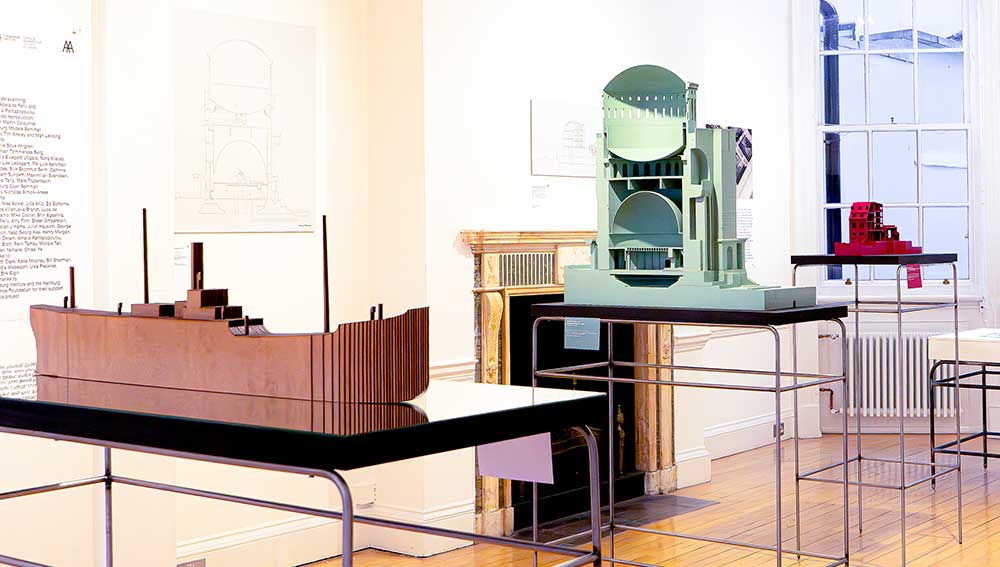
Warburg Models: The Architecture of the Itinerant Archive, installation view, Architectural Association School of Architecture, London. Photo: Elena Andreea Teleaga.
Chancellor’s Hall Lobby, Senate House, University of London*
17 January – 17 March 2024
and
The Gallery, Architectural Association School of Architecture, London**
19 January – 7 March 2024
by BRONAĊ FERRAN
I am approaching the wide entrance doors to the University of London’s Senate House on my way to view an exhibition about the building’s modernist architect, Charles Holden. When Senate House opened in 1937, housing a world-class library and special collections, as well the central administration for the University of London, it was the tallest secular building in the city.
Holden was already known as the architect of the tallest office block in London with his strikingly modernist London Transport building at 55 Broadway, for which he was awarded the RIBA Prize in 1931. When Senate House found a new temporary function during the second world war as the British Government’s Ministry of Information, its place in London’s urban mythology was secured. Behind its Portland Stone-clad exterior, many plans for covert operations and subterfuge were modelled and took form. Posters to encourage public support and resilience, not least the now infamous Keep Calm and Carry On were designed within its robust walls.
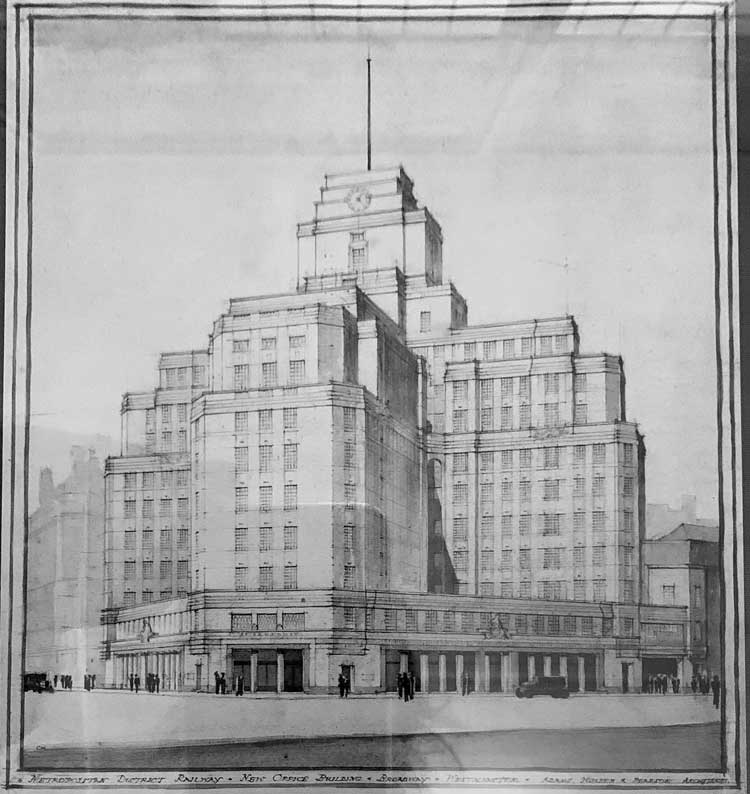
Charles Holden's London Transport building at 55 Broadway, built between 1927 and 1929. Photo: Bronac Ferran.
Referring to Senate House in 1937, Holden described it “an honest-to-God structure that actually does what it seems to be doing”, and in 1942, he said: “I do not think I have had any other ambition except to stand firmly by the truth to structure and to plan.” George Orwell then drew on it as inspiration for his Ministry of Truth in his dystopian 1948 novel Nineteen Eighty-Four. Its exteriors and interiors, its courtyard and its long corridors distributed over 19 storeys have been featured in many contemporary films including Batman Begins, The Dark Knight Rises and The Theory of Everything.
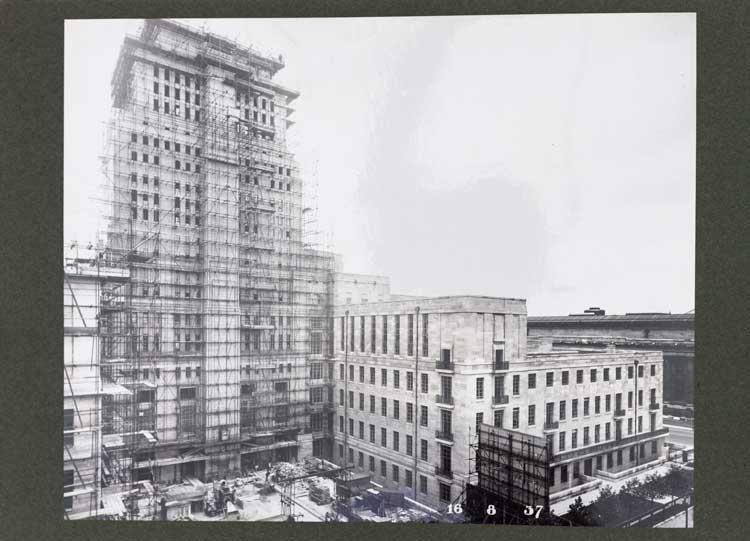
A photograph of the Senate House under construction, from the book University of London, The New Buildings, 6 January 1936 to 11 October 1937.
A highlight of this exhibition, co-curated by Richard Temple, Senate House’s archivist of special collections, and Bill Sherman, director of the Warburg Institute, is a surprisingly moving documentary film, made between 1932 and 1937, commissioned by the university from film-maker John Currie, about Senate House’s construction. It communicates a generative momentum of destruction, with a dramatic axing of trees and demolition of houses as the site was cleared to ready it for building.
A grant of £400,000 from the Rockefeller Foundation to the university enabled it to purchase the land from the Duke of Bedford. As Currie vividly captured on camera, extensive work took place “in winter and spring 1933” to ready the ground for action. Heavy machinery was moved into place and concrete structures were sunk into the ground to a level of 9 metres (30ft) to support the building’s foundations.
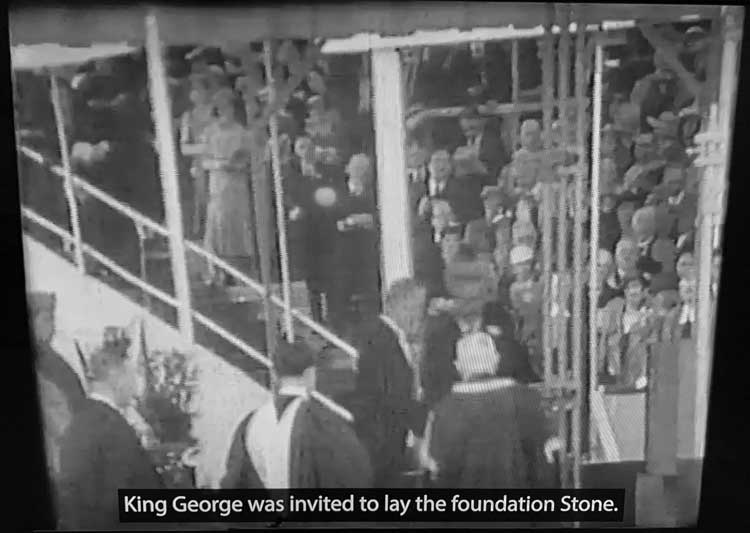
King George at the ceremony for the laying of the foundation stone, June 1933. Photo: Bronac Ferran.
The high degree of ceremony involved in the laying of the foundation stone by King George in June 1933 is conveyed in images and captions: “The Archbishop of Canterbury said a prayer” before a gathering of “some 3000 people”, including the chancellor of the University, the Earl of Athlone, along with “the Officers’ Training Corps” and “representatives of the major universities and learned societies of the world”. Gazing at this on a cold January morning this year in post-Brexit Britain, it seems like another world.
Displayed within glass vitrines are archival documents, including Part 1 of Holden’s contract, dated 1934. Costs then were projected to be £362,579 (a figure roughly equivalent to £23.5m today). As Ian Mansfield, director of research at the thinktank Policy Exchange, has observed this was “not just a contract” but “a huge, fat book” containing “a complete plan of what was to be built, right down to the doorknobs”. Mansfield has also noted that Holden reused the Johnston typeface, originally commissioned for his work with London Underground, in a 1932 book entitled University of London: New Buildings on the Bloomsbury Site, which is also here on display.1
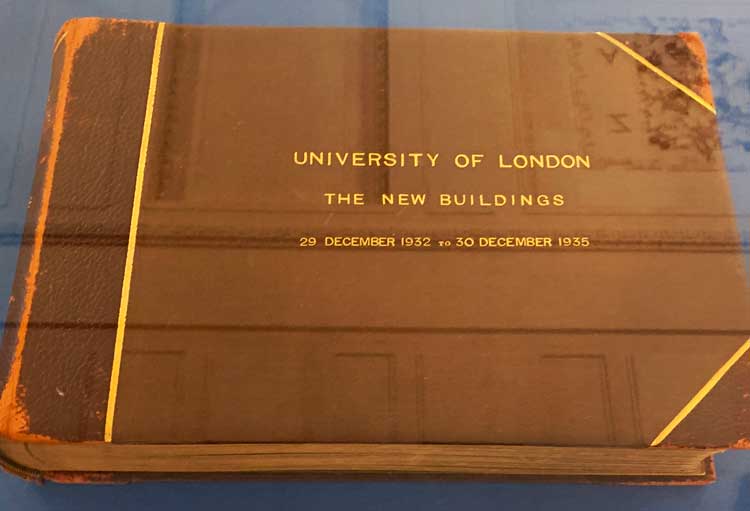
University of London: The New Buildings, 19 December 1932 to 20 December 1935. Photo: Bronac Ferran.
The way Holden used typography to create a sense of conceptual transference between expanding educational and transport infrastructures in a growing urban city illustrates his important place, via his works of the 20s and 30s in particular, within an international design lineage.
The fabric of Senate House underwent substantial refurbishment in 2006, making new spaces for other exhibitions, such as Shakespeare’s First Folio: a 400-Year Journey, as well as the smaller focus on Holden, who was also the architect of the much less modernist building that has housed the Warburg Institute since 1958.
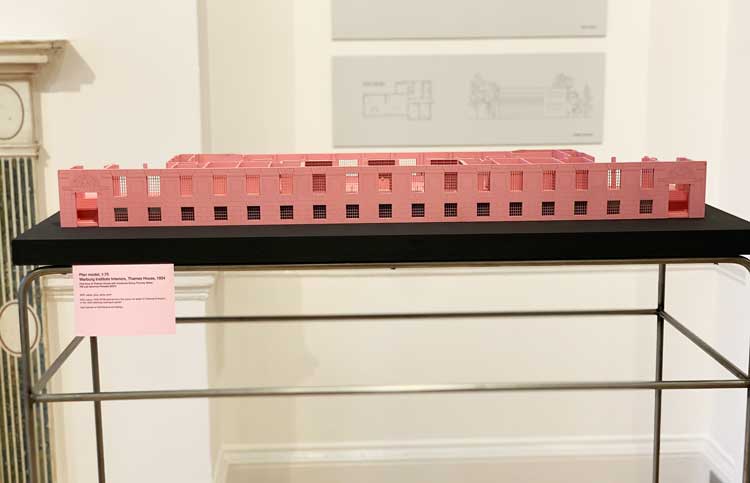
Warburg Institute Interiors, Thames House, 1934. Plan model, 1:75. PM Luis Sanchez-Parades, 2021. Oslo School of Architecture and Design. Photo: Bronac Ferran.
The exhibition includes architectural models of the Warburg, as it was then designed, alongside one of the building as it is now being extended to include a new lecture theatre and gallery to house public-facing activities. The nearby Architectural Association School of Architecture (AA) is currently given over to a thematically linked exhibition focusing on the library and the ideas of Aby Warburg (1866-1929), the German-Jewish born cultural historian, whose collection formed the basis of the Warburg Institute’s creation. Both these exhibitions form a coupled prelude to the opening of the newly extended institute, due this spring.
The AA exhibition highlights the different spaces and locations into which Warburg’s substantial collection shifted over the course of three decades, from the 1920s to the late 1950s. The exhibition originated as a masters student project at the Oslo School of Architecture and Design in 2021, before travelling to the Warburg-Haus in Hamburg and then to London. It is centred around colourful architectural models, made by the students. Added are an array of architectural drawings and a well-selected set of photographs, cuttings, letters and other ephemera that give embodied and personal form to the curatorial narrative.
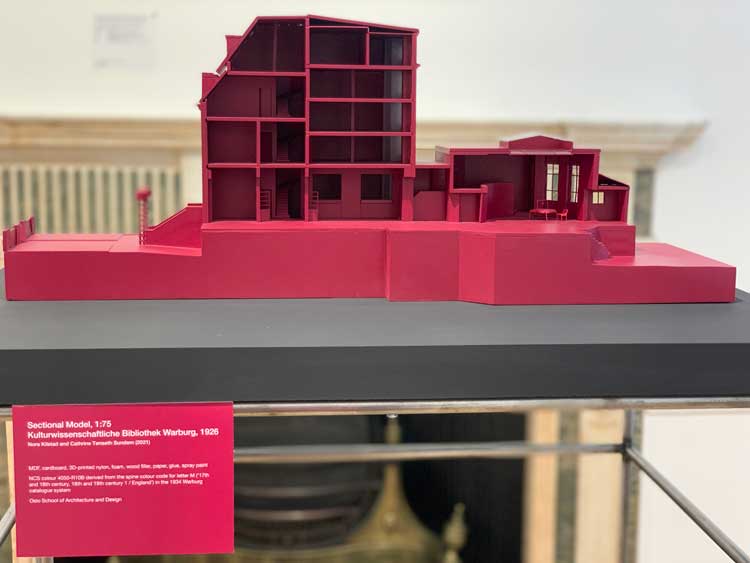
Kulturwissenschaftliche Bibliothek Warburg (Warburg Cultural Studies Library), 1926. Sectional model, 1:75. Nora Kilstad and Cathrine Tonseth Sundem, 2021. Oslo School of Architecture and Design. Photo: Bronac Ferran.
In an accompanying publication, the co-curators, Tim Anstey and Mari Lending, write of how Warburg – born into a wealthy German-Jewish banking family – opted out of the family business to concentrate instead on what they identify as systems of “cultural circulation”.2 After university, he spent time living in Florence as well as travelling to the United States where he absorbed aspects of the cosmology of the Hopi Native American tribe in Arizona and other Native American peoples living in “pueblos” in New Mexico. He was in search of a new way of bridging art historical and anthropological systems of knowledge.
On his return, he came up with the concept, with which his legacy is now closely associated, of the Bilderatlas Mnemosyne (Image Atlas of Remembrance), which appears to anticipate hyperlinking capabilities that digitally networked systems facilitate. For Warburg, the task was one of gathering, researching and displaying text and image-based material, revealing the ways recurrent visual patterns emerge and recur in different constellations over historical and present times, using processes of collaged edge connections and lateral perceptual flows to make these visible. Warburg collected copious numbers of books and photographic images to substantiate this theory, referring to these as “working tools in a scientific laboratory”.3 The writer Chloe Aridjis, meanwhile, has referred to Warburg’s library as well as his ideas of a Bilderatlas Mnemosyne as “models of his mind in its febrile cross-pollination”.4 That Warburg was continuously modifying and shifting elements around within the hundreds of image and text assemblages and combines that he created is a notion that also plays into the curatorial idea of itinerant archives: there is an overwhelming sense of a person wrestling with an unsettling and unsettled abundance.
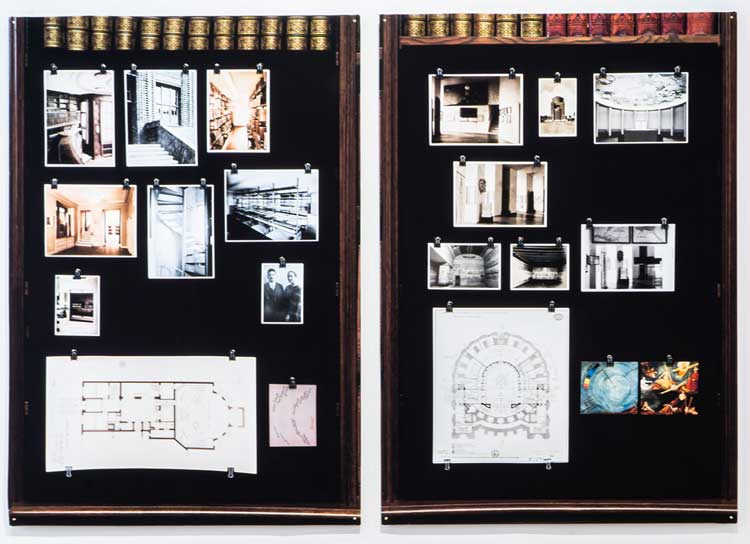
Installation view, Warburg Models: The Architecture of the Itinerant Archive, Architectural Association School of Architecture, London. Photo: Elena Andreea Teleaga.
During the 1920s, Warburg’s overflowing private library was shifted into an adjacent building in Hamburg, the interior of which had a reading-room shaped like an ellipsis. The collection was distributed over four floors, each of which had a different organising theme: image, orientation, word and action. Books were positioned using a combination of letters and coloured strips attached to their spines. The interior design developed in Hamburg, from size of book stacks to coloured-coded index cards to the angle of light through the reading-room windows, became the model that inspired future iterations of the temporary and permanent spaces in this country in which Warburg’s collection has resided.
The shift to England was prompted – like many other dreadful displacements caused by the ascent of National Socialism in Germany in the early 1930s – by the initial violent threat to books and other material artefacts linked to Jewish families, that augured the soon-to-be-made-real onset of human destruction. Support increased for the idea of shifting Warburg’s library – which evolved after his death into an institute with links to the University of Hamburg between 1931 and 1933 – out of the country, perhaps to Leiden, or to somewhere in the US, where some members of Warburg’s family lived. But the decision to go to England was smoothed by careful diplomatic subterfuge generated by a British committee chaired by the aristocrat and philanthropist Lord Lee of Fareham and with input from academics, for example, from the University of London’s School of Oriental and African Studies, who could perceive the value of what Warburg had been autonomously collecting. A letter from Lee sent in October 1933 to Max M Warburg, Aby’s younger brother, conveys something of the covert strategies used to extricate the collection before its likely seizure. Lee informed Warburg: “The most difficult part of the task lay ahead, namely obtaining permission from the Nazi authorities to move the institute. To have requested authorisation for a permanent transfer of the institute would have involved such problems as taxation and foreign exchange claims. Since, however, the Nazis were actually preventing the functioning of the institute in their own country, what could have been more natural than for a distinguished British committee to invite the institute to visit England for a three-year period?”5
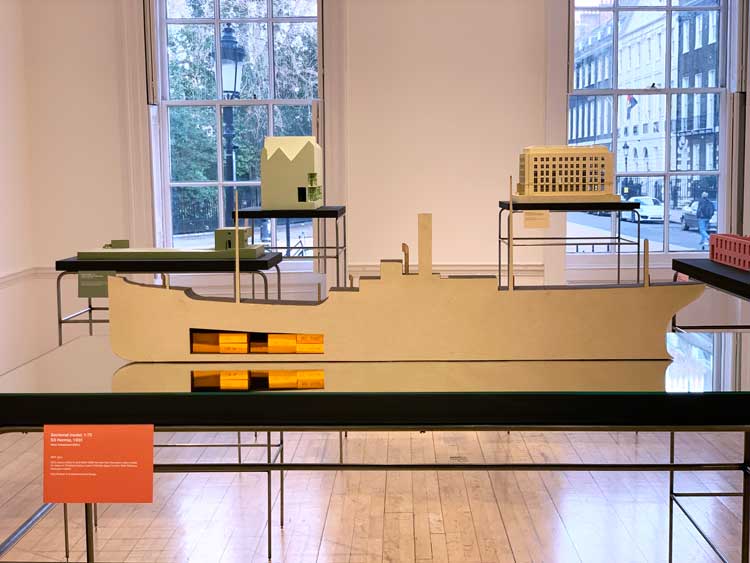
SS Hermia 1933. Sectional model, 1:75. Mara Trübenbach, 2021. Oslo School of Architecture and Design. Photo: Bronac Ferran.
In December 1933 and January 1934, Warburg’s collection of more than 60,000 books, many thousands of photographs and slides, index cards, library fittings and other items were dispatched to London. The exhibition includes a large Sectional Model of the SS Hermia, a vessel that was used for transportation. Crucial financial support for moving and then housing the exhibition in London came from Samuel Courtauld, the industrialist and art collector who founded the Courtauld Institute in 1932, as well as the Warburg family.
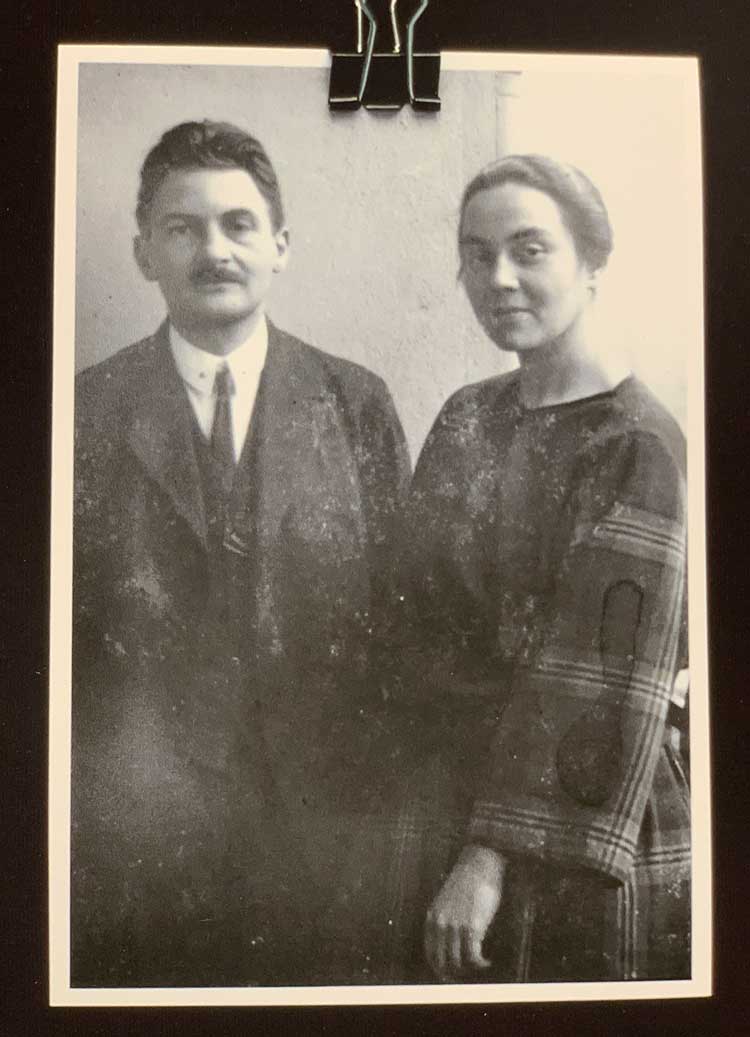
Gertrud Bing and Fritz Saxl. Installation photo: Bronac Ferran.
Two of Warburg’s most trusted colleagues, Gertrud Bing and Fritz Saxl, the latter of whom was a librarian in Warburg’s library from 1913 and became director after Warburg’s death, also came to London with the collection and, at some point, the pair began to co-habit. But their hopes of building a new residence – with two separate entrances – to be designed by the Tecton group, that we see also in model form in this exhibition, was not to be realised. Warburg had worked closely with Saxl from 1927-29 on what we would now perceive as an immersive installation based on a combination of astrological and astronomical elements that they drew on to seek to create “a historical understanding of the heavens and their relationship with human destiny as manifest in cultures from Ancient Babylon and Egypt to modern Europe” for display in a recently opened Planetarium in a disused water tower in Hamburg.6 Warburg died in 1929, the year before this concept was physically realised. A pale green model of the Planetarium can be found in the AA Gallery.
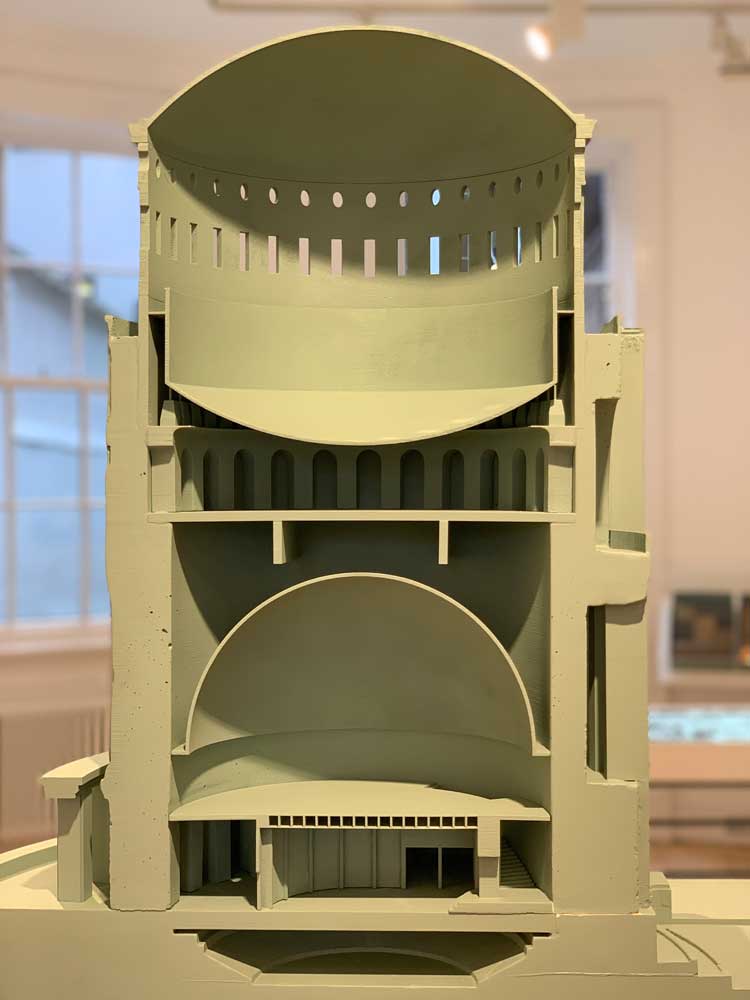
Hamburg Planetarium, 1930. Sectional model, 1:75. Maximilian Svendsen, 2021. Oslo School of Architecture and Design. Photo: Bronac Ferran.
Saxl and Bing played critical roles in successfully sustaining Warburg’s legacy in London. Among the most interesting correspondence reproduced are letters that reveal the care they took to try to source appropriate fixtures and fittings for the temporary spaces. A flexible reading-room, that doubled as a lecture theatre, created in the then state-of-the-art Thames House building, near the heart of the British political establishment, on the Lambeth Embankment, was the temporary residence for the collection from 1934-37. A wonderfully evocative photograph of this room in the display reflects the involvement of the architect Godfrey Samuel, who was part of Tecton, then a stunningly innovative architectural practice, which existed from 1932-39 and was responsible for iconic constructs such as the Penguin Pool at London Zoo. The group’s work generally exemplified the migration of continental design modernism into the English context. That Warburg’s collection and its state of relative itineracy for a time became a cross-fertilising and stimulating force of innovative influence in its own right, beyond the lifetime of its founder, on being “transplanted” into another site and context, is a vital insight that this exhibition brings into significant focus.
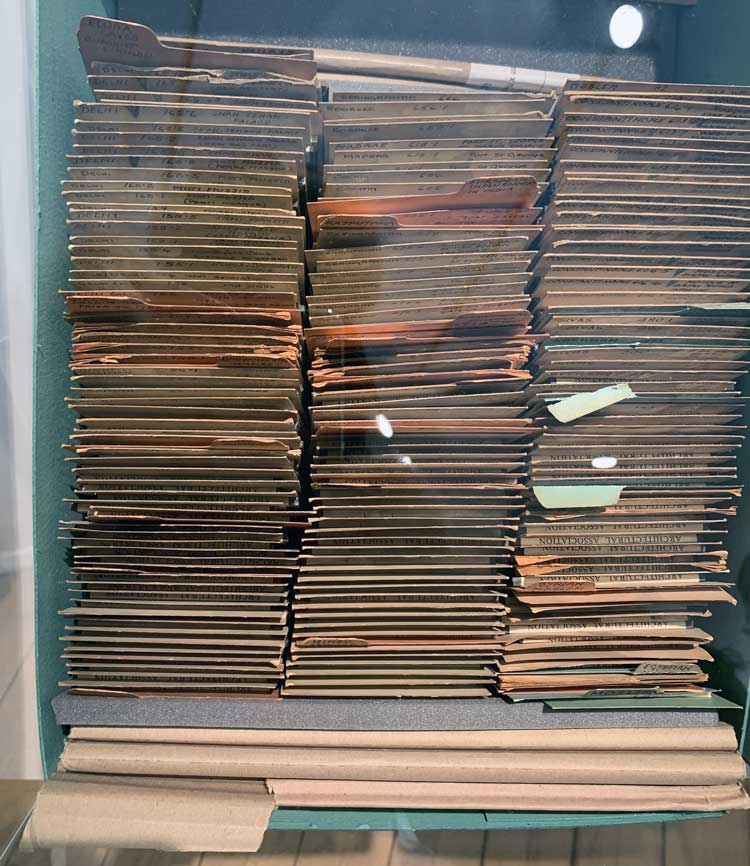
A stack of Lantern Slides. Installation view. Photo: Bronac Ferran.
Another enduring after-image that I took away was of a display of items from the AA’s little-known collection of lantern slides, as former teaching aids that were once much-used and have been preserved in organic piles, in their original folders, stacked in loosely linear columns, one upon the other, titles almost wholly hidden. While remaining spatially located within the AA’s own archives, these slides are itinerant in terms of their temporal positioning. Yet this exhibition offers them a mode of conceptual reframing, and indeed reclaiming, within Warburg’s art historical cosmology.
As Anstey and Lending describe in their opening essay in the accompanying publication, what Warburg found compelling were “antique representations” of former cultural flows that later find expression in forms of “frozen movement”.7 This is an ideal description of the array of lantern slides, which appears both cut-off in time and restored to present reappreciation, within an understanding of how the nach-leben or afterlife of cultural forms can sometimes find new currency, and indeed recirculation, through the distilling act of good curation.
References
1. This is a citation from Ian Mansfield, see here.
2. Warburg Models: Buildings as Bilderfahrzeuge, edited by Tim Anstey and Mari Lending, published by Hatje Cantz Verlag GmbH, 2023, pages 9-19.
3. This is cited in an article on the Warburg Institute relating to a virtual exhibition in 2016: see here.
4. At the HKW by Chloe Aridjis, London Review of Books, 5 November 2020.
5. This a citation from the Warburg Institute’s website where the story of the transfer of the collection to London is expanded: see here.
6. Anstey and Lending, op cit, page 12.
7. Anstey and Lending, op cit, page 9.